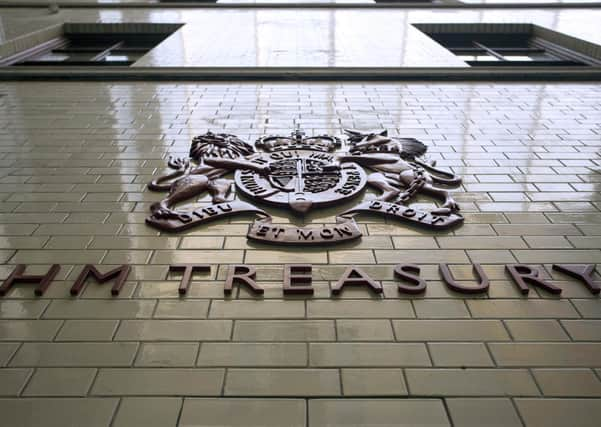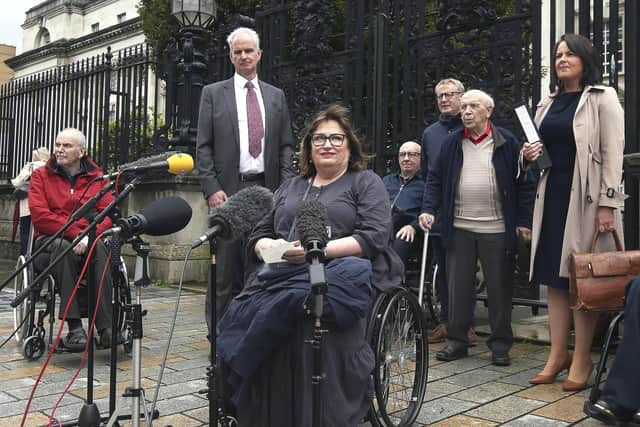Ben Lowry: The cost of victims’ pension has ballooned without explanation as to why, or debate about whether the scheme needs to be so large


London and Stormont both say they want the pension to proceed.
Yet the cost of this pension has ballooned, with little explanation.
Advertisement
Hide AdAdvertisement
Hide AdAt a time of national financial crisis caused by Covid, including ruin of industries, there has been cross-party political agreement in Northern Ireland that the pension must be paid, regardless of the vast expense.


There has been barely any media scrutiny of whether or not the scheme represents value for money, the main debate now is who picks up the tab (with, as usual at Stormont, unanimity that London must shoulder a large part of it).
In recent months I have listened to panel discussions in which all contributors agreed that Westminster had such a financial obligation and in which no-one queried cost.
I have heard unionists agree with defenders of the long IRA campaign, which caused so many of the injuries that are eligible for compensation, that London — which has spent hundreds of billions on NI during and since the Troubles — is dragging its feet on the pension.
Advertisement
Hide AdAdvertisement
Hide AdNot long ago, the debate about the pension for victims of the Troubles was largely about eligibility. There was dispute over whether someone injured by their own hand when planting a bomb should get the pension (akin to the debate over whether or not such a person should be defined as ‘a victim’).
During that eligibility debate, in 2017, an informed commentator wrote on these pages that there were 400 seriously incapacitated people from the Troubles, around a dozen of whom were terrorists.
This person suggested that the small number of injured bombers be funded by the paramilitary groups that gave them their orders, using the groups’ ill gotten riches. This would let the pension proceed for everyone else, without being tainted by paying perpetrators.
Recently I asked people, including lobbyists for victims’ groups, if 400 was an accurate estimate of the number of victims (see below a quote that Alan McBride gave me on the pension).
Advertisement
Hide AdAdvertisement
Hide AdFrom those conversations I understand that the number of Troubles severely physically disabled people in NI is around 500. The number of severely psychologically damaged people is similar. That suggests a total of around 1,000 people who are badly disabled due to the past violence.
How has the victim pension row gone from being about eligibility for the scheme to one about liability for costs?
And how has it become a scheme that, a few years ago, was expected to apply to a small pool of badly injured people into one so huge and expensive that there are doubts as to its feasibility?
Last month, Mark Browne from Stormont’s Executive Office told MLAs legislation for pensions was established without a full understanding of what the cost.
Advertisement
Hide AdAdvertisement
Hide AdStormont also heard from the finance minister, Conor Murphy, that he overall scheme could cost as much £1.2 billion. That is a maximum figure, but even the lowest cost estimates anticipate a scheme that has thousands of recipients.
So I approached three government departments. I outlined my rough understanding of the numbers of recipients and the costs, and asked if my understanding was correct (see below my questions and the answer I got, which did not address some of my queries).
In writing this piece, I do not dispute the obvious fact that, in addition to the 3,700 people killed in the Troubles, thousands more had their lives destroyed.
Most of us who did not suffer are humbled when we see the dignity of victims, such as Jennifer McNern, who like her sister lost both legs in the Abercorn bomb, and Richard Moore, blinded by a soldier.
Advertisement
Hide AdAdvertisement
Hide AdFor half a century, they have had to adapt to devastating injury. Barely anyone would dispute that a civilised society has a duty to provide generous, life-long care to such victims of appalling injury.
But if this pension is paying out to tens of thousands of people, then clearly most of the recipients will have suffered much lesser injuries.
Note that some dubious estimates of the number of Troubles victims have been made, and faced minimal challenge, including a claim some years ago by a trauma expert that 200,000 people in NI were “bereaved” in the conflict (it would take an entire article to explain why I dispute that figure).
If this pension scheme has been drawn in a way that it includes lesser injuries, then other questions arise such as:
Advertisement
Hide AdAdvertisement
Hide Ad• are the lesser injuries not already getting state disability payments?
• did some of the injured get past generous redundancies like Patten?
• if yes to both queries above, is it appropriate now to spend on extra funds for thousands of such people?
• are there not people damaged in other ways, such as by Covid, who are as deserving of that public money?
Advertisement
Hide AdAdvertisement
Hide AdThat some of these questions seem barely to have been asked at Stormont raises fresh doubts about the calibre of our local governance.
(Scroll all the way down for other articles by Ben Lowry)
• My question to government departments about the cost of the scheme:
I approached Stormont’s department of Justice, department of Finance, and the Northern Ireland Office. I asked them if my understanding of the pension scheme, as follows, was accurate and if not how not:
“As I understand it from recent comments, the cost of the pension scheme is between £600m and £1.2 billion. This is an ultimate cost.
Advertisement
Hide AdAdvertisement
Hide Ad“The first year might cost £145m. Admin might be £40m for the first five years, thus £8m a year.
“Payments might be £2,000 to £10,000 per person per year, let’s say a median of £6,000.
“Thus you are estimating that perhaps 20,000+ people will be eligible for annual payments (20,000 x 6,000 = £120m, which is well below your highest first year estimate),
“Some 3,700 people were killed in the Troubles. If we assume five serious injuries for every death, that is perhaps 20,000 serious injuries during the Troubles, most of which happened almost 50 years ago, and many of the injured will be dead.
Advertisement
Hide AdAdvertisement
Hide Ad“Please advise if you think I have gone wrong in my points, above.
“Can you explain why you think the costs of this scheme will be so high? Is this cost appropriate at a time of immense financial pressure due to a pandemic?
“What measures do you propose to control the costs or will your view be that everyone who meets the criteria gets payment, regardless of cost?”
The NIO declined to comment. Stormont’s justice and finance departments directed me to the Executive Office (TEO). A spokesperson for it said:
Advertisement
Hide AdAdvertisement
Hide Ad“Officials carried out extensive scoping work to determine potential numbers of successful applications to the Victims’ Payment Scheme for Permanent Disablement and engaged the Government Actuary’s Department (GAD) to provide detailed modelling based on those estimates. The cost estimate range of £601m to £1.2bn is for the lifetime of the scheme, which could last for 80 years or more, and does not include administration costs. GAD modelled the estimated numbers, taking into account the backdating element and lump sum entitlement for those aged 60 and over, as well as other assumptions, to arrive at the cost range.
“The Victims Payments Regulations set out the eligibility criteria, and costs have been modelled based on the best estimates of numbers who may qualify for the scheme. The regulations, developed by the NIO, go further in terms of eligibility than was originally envisaged when the scheme was first identified in the Stormont House Agreement.
“In line with the Victims Payments Regulations 2020, anyone who meets the eligibility criteria and is suffering from permanent disablement is legally entitled to receive a payment.
“Ministers are committed to resolving the important issue of funding for the scheme and are continuing to liaise with executive colleagues and the Secretary of State to find a way forward on this matter.”
Advertisement
Hide AdAdvertisement
Hide Ad• Quote that the victim campaigner Alan McBride gave me about the pension delay and costs:
“The pension will cost what it will cost, that is not for victims to determine, but I do take issue with politicians who say that if it comes from the Block grant it will lead to a cut in health and education and other services. To put that guilt on victims and survivors after all they have been through is just wrong. Costs of the scheme and how it is managed is the responsibility of the injured pensions payment board”
• Ben Lowry (@BenLowry2) is News Letter deputy editor
• Ben Lowry Feb 27: Unionists have fully turned against Irish Sea border because they’ve seen the scale of disaster
• Ben Lowry Feb 20: We still lack answers as to why IRA funeral got special treatment at Roselawn
Advertisement
Hide AdAdvertisement
Hide Ad• Ben Lowry Feb 13: Peter Robinson has long experience of what is and is not politically feasible
• Ben Lowry Feb 6: There is barely any unionist support for violence, despite justified anger at sea border
• Ben Lowry Jan 30: At last, clear reason for UK and unionists to stop being weak towards Ireland/EU
• Ben Lowry Jan 23: Lockdown sceptics have been undermined by crazy theories, but sensible criticisms haven’t gone away
Advertisement
Hide AdAdvertisement
Hide Ad• Ben Lowry Jan 16: The Irish Sea border was imposed because UK knew unionists would take it
• Ben Lowry in 2020: Last night unionists celebrated a move towards Irish unity
——— ———
A message from the Editor:
Thank you for reading this story on our website. While I have your attention, I also have an important request to make of you.
With the coronavirus lockdown having a major impact on many of our advertisers — and consequently the revenue we receive — we are more reliant than ever on you taking out a digital subscription.
Advertisement
Hide AdAdvertisement
Hide AdSubscribe to newsletter.co.uk and enjoy unlimited access to the best Northern Ireland and UK news and information online and on our app. With a digital subscription, you can read more than 5 articles, see fewer ads, enjoy faster load times, and get access to exclusive newsletters and content. Visit https://www.newsletter.co.uk/subscriptions now to sign up.
Our journalism costs money and we rely on advertising, print and digital revenues to help to support them. By supporting us, we are able to support you in providing trusted, fact-checked content for this website.
Alistair Bushe
Editor